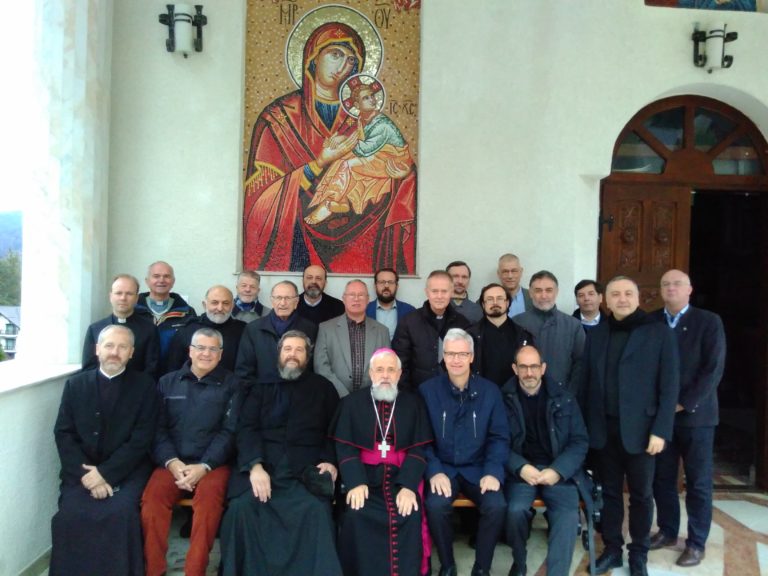
The Saint Irenaeus Joint Orthodox-Catholic Working Group gathered for its fourteenth annual meeting from 4 to 8 October 2017 at Caraiman Monastery (Romania), at the invitation of the Romanian Orthodox Church. The 2017 meeting was chaired by the Catholic Co-president of the Working Group, Bishop Gerhard Feige of Magdeburg. The group sincerely thanked its former Co-President Archbishop Job of Telmessos who had to withdraw from the group due to the fact that he became Co-President of the Joint International Commission for Theological Dialogue between the Catholic and the Orthodox Churches.
Before the opening session on Wednesday evening, October 4, the group was warmly welcomed by His Grace Ieronim Sinaitul, patriarchal Vicar Bishop, on behalf of His Beatitude Daniel, the Patriarch of the Romanian Orthodox Church. The group members visited the Antim Monastery, the Patriarchal Cathedral and the Patriarchal Palace in Bucharest. On Thursday morning the group was warmly welcomed by Archimandrite father David Petrovici, the abbot of Caraiman Monastery. Throughout the meeting, the participants attended the daily prayers of the monastic community. On Sunday, the participants attended the Divine Liturgy in the White Church, Bucharest, over which His Grace Varlaam Ploiesteanul, patriarchal Vicar Bishop, presided.
This year’s meeting concentrated on some aspects of the relationship between primacy and synodality, with the goal of preparing the final common study on this issue. The papers dealt with the role of the Eastern patriarchates in the first millennium, the role of the Apostle Peter in the ecclesial tradition in East and West and the right of appellation (ekkliton) in East and West. The reflections of this year’s meeting were summarized by the participants in the following theses:
Theses on the role of the Eastern patriarchates in the first millennium
(1) The famed model of pentarchy (rule of the five ancient patriarchates of Rome, Constantinople, Alexandria, Antioch, and Jerusalem) was rarely fully functional. Roman reservations, the Chalcedonian schism and, especially, the Arab conquest, gravely restricted its operation in practice.
(2) The patriarchal model of Church governance was superimposed on the metropolitical system (i.e. the system of Church governance based around the capital city of the province). The patriarchal model was based on a complex mixture of considerations relating to apostolic foundation, custom, geography, power, and politics. It is a story of considerable competition and antagonism.
(3) The history of the five ancient patriarchates is also a story of a search for ecclesial unity and concern for orthodoxy. The five ancient patriarchates have served throughout history as visible manifestations of the unity of the Church, most notably in the context of the Ecumenical Councils.
(4) The split between East and West and indeed a number of ongoing tensions within the Orthodox Church (e.g. concerning primacy and synodality) are to some extent the legacy of the patriarchal system.
Theses on the role of Apostle Peter in the ecclesial tradition in East and West
(5) The special standing of Peter within the college of the apostles, as Holy Scripture witnesses to, is also reflected in the liturgical tradition. In both Roman and Byzantine rites the Apostle Peter is commemorated together with the Apostle Paul on June 29th. In the Roman rite the feast of the Apostles is a solemnity; in the later Byzantine tradition, it is preceded by a special period of fasting which emphasises the special standing of both of these Apostles.
(6) As early as in the second century, the Church of Rome associated itself with Peter who witnessed to Christ and suffered martyrdom in Rome. Very soon afterwards, his grave was venerated. The veneration of Peter’s (and Paul’s) graves, combined with the importance of Rome as the imperial capital, formed the basis for the special standing accorded to the Bishop of Rome from the third century onwards.
Thesis on the right of appeal (ekkliton) in East and West
(7) The canonical right of appeal (ekkliton) goes back to the first millennium. The Quinisext Council (691-92), considered to be of ecumenical standing, passed in review the previous canons and mentioned those still valid in canon 2. Among these is to be found the right of a bishop condemned by a local synod to appeal to the bishop of Rome, according to the canons of the synod of Sardica (343). This provision constitutes an important basis for any future agreement on primacy between Orthodox and Catholic.
At the end of their meeting the members of the Irenaeus Group expressed warm thanks to Patriarch Daniel, the Romanian Orthodox Church and to the monastic community of Caraiman Monastery for the hospitality and the spiritual atmosphere which inspired their work.
The Saint Irenaeus Joint Orthodox-Catholic Working Group is composed of 26 theologians, 13 Orthodox and 13 Catholics, from a number of European countries, the Middle East and the Americas. It was established in 2004 at Paderborn (Germany), and has met since then in Athens (Greece), Chevetogne (Belgium), Belgrade (Serbia), Vienna (Austria), Kiev (Ukraine), Magdeburg (Germany), Saint Petersburg (Russia), Bose (Italy), Thessaloniki (Greece), Rabat (Malta), on Halki near Istanbul (Turkey) and at Taizé (France). It was decided at Caraiman to hold the next meeting of the Irenaeus Group in October 2018 in Graz (Austria).